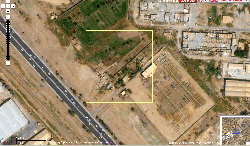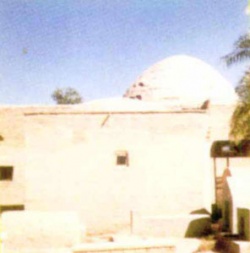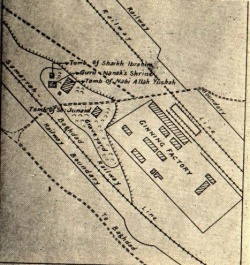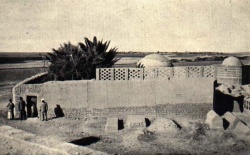Guru Nanak in Baghdad: Difference between revisions
Navroopsehmi (talk | contribs) m (→References) |
(Links of historic photos of shrine added) |
||
| (69 intermediate revisions by 11 users not shown) | |||
| Line 1: | Line 1: | ||
{{fa|43}} | |||
{{p|Image:Baghdad.jpg|[[Gurdwara in Baghdad]]}} | |||
After travelling to {{w|Madina}}, [[Guru Nanak Dev]] soon arrived in [[Baghdad]] and took up a position, along with [[Mardana]], outside of the city. Guru Nanak Dev Ji shouted the call to prayer, a gesture upon which the whole population became wrapped in silent astonishment as the Guru had omitted the usual words ''Muhammad ar Rasul Allah'', and substituted Arabic words of a similar sound to express his own ideas. | |||
In [[Iraq]], it is said, "Even today there are several disciples of Guru Nanak in Iraq. These people live on the banks of the [[Tigris]] river, particularly in the cities of [[Al Kut]] and [[Baghdad]]. They are called [[Sobi]] and generally they are gold-smiths by occupation. They are experts in their trade. They keep long hair and do not cut their beards and remember the Guru by names of Baba Nanak or Baba Nana." | |||
<center>'''[[Guru Nanak in Baghdad|Baghdad]]'''<br></center> | |||
==The Guru's visit and shrine == | |||
[[Image:Gurunanak_shrine_baghdad_map.jpg|250px|thumb|location of shrine, map of Baghdad|Map of Baghdad in 1931 shows the location of Guru Nanak's shrine. It is one mile to the right of the Tigris River and a mile-and-half from Baghdad Railway Station West, between two railway lines.Image rotated 90 degree form source document |left]] | |||
The | The shrine of Guru Nanak the founder of the [[Sikh]] faith is located in Karkh District in Sheikh Maaruf Neighbourhood. This shrine can be reached from a road that goes from Sheikh Maruf Cemetary towards 14 July Road. In the shrine, the following inscription is engraved: "Guru Nanak headed for Baghdad as a traveler, and there he took a house for himself at its gates." On the 23rd of November, 1969, his followers celebrated his 500th birthday by erecting a memorial statue at his tomb. | ||
Karkh, or Al-Karkh, is historically the name of the western half of Baghdad in Iraq, or, alternatively, the western shore of the Tigris River as it runs through Baghdad. The eastern shore is known as [[Al-Rasafa]].[1] Today, it is also a neighborhood between the international zone and the Tigris. Karkh is one of nine administrative districts in Baghdad. | |||
==Meeting Bahlol, the Pir from Baghdad== | |||
The Pir (saint) of Baghdad, [[Bahlol Dana]], on a face-to-face meeting with the enthusiastic stranger, inquired who he was and to what sect he belonged. The Guru greeted him with his customary ‘Sat Kartar’ and replied, “I have appeared in this age to indicate the way unto men. I reject all sects, and only know one God, whom I recognize in the earth, the heavens, and in all directions.” | |||
Upon this the Guru began to repeat the [[Japji]]. As the pir listened to his doctrines, he said, “This is a very impious fakir. He is working miracles here, and informing us, contrary to the authority of our [[Holy Qur'an]], that there are hundreds of nether and upper regions, and that at last men grow weary of searching for them.” Guru Ji spoke: | |||
The | ''"There are nether worlds and more nether worlds below them and hundreds of thousands of skies above them. | ||
The [[Veda]]s (religious texts) pronounce that people are tired of searching Gods limits and boundaries. | |||
The saints, puranas, religious texts of Christians and Jews conclude that God is limitless. | |||
If there is any account of God, then a lone mortal can write the same. | |||
His account does not finish but the mortal succumbs to death, | |||
Nanak says that only the Almighty knows his limits."'' | |||
== Pir Bahlol is impressed== | |||
[[Image:Baghdad-from-air.gif|thumb|250px|right|<small>Possible location of [http://wikimapia.org/#y=33371610&x=44325848&z=18&l=23&m=a&v=2 Gurudwara in Baghdad] from the air. (image from wikimapia.org)*[http://www.panoramio.com/photo/68079666 this link shows exact location of Guru Nanak's visiting place on panoramio site with photo] </small>]] | |||
(This was well before [[Galileo]] looked into the night sky. In other sections of Japji Sahib, Guru Nanak speaks of infinite brahmands (universes/galaxies), planets, suns, moons, oceans, and continents. One does not have to wonder if there are earth-like planets, but that in fact there are so many planets like ours that harbor oceans and continents.) | |||
Guru Ji speaks of limitless religious texts and saints (like the [[Buddha]]) throughout the entire expanse of the cosmos, countless languages, and earth-like regions. Yes, there is life out there and many more religions than we can imagine! (www.sikhs.org , Japji Sahib translation)'' | |||
The | The pir then called upon the Guru to give a manifestation of his power. Upon this, it is said, the Guru laid his hand on the high priest’s son and showed him the upper and lower regions described in the Japji. | ||
==Bhai Gurdas Ji's Var== | |||
Bhai Gurdas Ji says the following of Guru Nanak Dev ji's visit to Baghdad: | |||
[http://www.sikhitothemax.com/Page.asp?SourceID=B&PageNo=01&ShabadID=5575&Format=2 Read at SikhiToTheMax] | |||
''From Mecca, Baba went to Baghdad and stayed outside the city.'' | |||
''Firstly, Baba himself was in the form of Timeless and secondly, he had his companion Mardana, the rebeck player.'' | |||
''For namaz (in his own style), Baba gave call, listening to which the whole world went into absolute silence.'' | |||
''The whole city became quiet and lo! to behold it, the Pir (of the town) also got wonder-struck.'' | |||
''Observing minutely he found (in the form of Baba Nanak) an exhilarated fakir.'' | |||
''Pir Dastegir asked him, which category of fakir you belong to and what is your parentage.'' | |||
''(Mardana told) He is Nanak, who has come into kaliyug, and, he recognizes God and His fakirs as one.'' | |||
''He is known in all the directions besides just earth and sky.'' | |||
Who is [[Pir Dastgir]]? The Persian word “Dastgir” literally means holder of hand but is interpreted as “one who rescues or leads by the hand.” This was the appellation applied to [[Sheikh Abdul Qadir Jilani]] by which his successors would not unnaturally be referred to. | |||
==Guru Nanak Dev's Shrine in Baghdad== | |||
{{coord 2|33.3361125|||N|44.3637969|||E}} | |||
[[Image:Guru nanaks shrine in baghdad.jpg|250px|thumb|Guru Nanak Dev Ji's Shrine, Baghdad|right]] | |||
{{main|Gurudwara in Baghdad}} | |||
During the [[Great War]], when the British and Indian armies conquered Baghdad, they discovered the place where Guru Nanak had his discourse with Bahlol. It lies to the west of the town and between the old graveyard to the north and the present Baghdad-Samara railway line to the south. [[Dr. Kirpal Singh]], then a Captain in the [[Indian Medical Service]], also saw it during the war, and he, in his letter, dated October 15, 1918, described it as follows: | |||
"It is really a humble looking building and known to very few people except Sikhs. To some Arabs it is known as well by the name of tomb of Bahlol. You enter the building by a small door, on which something is written in Arabic, not visible to a casual visitor. Even with attention it is difficult to read. I could not read it hence could not copy it. I have taken the photograph of the outside, which I shall forward to you in due course. Entering the building, you come to a brick paved passage going to your right straight into the room (with a veranda), wherein you find the tomb and the raised platform. In the courtyard there are a few trees, mostly pomegranates. | |||
==See also== | |||
* [[Baghdad]] | |||
* [[Gurudwara in Baghdad]] | |||
* [[News about Gurudwara in Baghdad]] | |||
{| | |||
|width=25%| | |||
* [[Guru Nanak at Hassan Abdal]] | |||
* [[Guru Nanak at Eminabad]] | |||
* [[Guru Nanak in Baghdad]] | |||
* [[Guru Nanak in Tibet]] | |||
* [[Guru Nanak in Nepal]] | |||
* [[Guru Nanak In Sri Lanka]] | |||
* [[Guru Nanak in East India]] | |||
* [[Guru Nanak in Mecca]] | |||
* [[Guru Nanak in Saudi Arabia]] | |||
* [[Guru Nanak in Pakpattan]] | |||
|width=25%| | |||
* [[Guru Nanak in Greece]] | |||
* [[Guru Nanak at Gaya]] | |||
* [[Guru Nanak in Maharashtra]] | |||
* [[Guru Nanak in Iran]] | |||
* [[Guru Nanak in Azerbaijan]] | |||
* [[Guru Nanak in Uzbekistan]] | |||
* [[Guru Nanak In Bangladesh]] | |||
* [[Guru Nanak at Puri]] | |||
* [[Guru Nanak in Manipur]] | |||
|width=25%| | |||
* [[Guru Nanak in Rome]] | |||
* [[Guru Nanak at Medina]] | |||
* [[Guru Nanak at Shikarpur]] | |||
* [[Guru Nanak in Italy]] | |||
* [[Guru Nanak In Syria]] | |||
* [[Guru Nanak In Bhutan]] | |||
* [[Guru Nanak in Afghanistan]] | |||
* [[Guru Nanak in Egypt]] | |||
* [[Guru Nanak in Uganda]] | |||
* [[Guru Nanak in Africa]] | |||
|} | |||
==External Links== | |||
* http://www.sikhism.com/gurdwara/baghdad_gurdwara.htm | |||
* [http://www.sikhspectrum.com/072002/baghdad.htm www.sikhspectrum.com] | |||
* [http://www.punjabilok.com/faith/gurudwara/gurdwara_in_baghadad.htm www.punjabilok.com] | |||
* [http://www.punjabielm.co.uk/iraqi_sikh_temple.htm punjabielm.co.uk] | |||
* [http://www.info-sikh.com/BhagPage1.html www.info-sikh.com] | |||
* [http://www.allaboutsikhs.com/gurudwaras/gurud_37.htm www.allaboutsikhs.com] | |||
* [http://www.sikhism.com/articles/guru_nanak.htm www.sikhism.com] | |||
* [http://www.sacred-texts.com/skh/tsr1/tsr118.htm www.sacred-texts.com] | |||
* [http://www.hinduonnet.com/2001/12/12/stories/2001121200601000.htm www.hinduonnet.com] | |||
* [http://www.sikhreview.org/november2006/history2.htm sikhreview.org] | |||
* [http://timesofindia.indiatimes.com/articleshow/47702459.cms indiatimes.com] | |||
* [http://www.experiencefestival.com/a/Guru_Nanak/id/50430 experiencefestival.com] | |||
* [https://youtu.be/gAIcpmaZHH0 united sikhs year 2021 report and service to place of Gurdwara in Baghdad] | |||
* [https://www.google.co.in/search?q=Sikh%20shrine%20in%20Baghdad%20lives%20on%20in%20memories.%20anwar%20faruqi%20AFP&tbm=isch&client=safari&cs=1&hl=en-GB&sa=X&ved=0CAEQv7IFahcKEwjY-I_1gOT5AhUAAAAAHQAAAAAQBg&biw=1121&bih=1311&dpr=2#imgrc=nFM6PXlowTAfNM&imgdii=O6d9cbChUsOltM. Some historic photos of shrine by Amardeep film maker of Allegary of Travels of Guru Nanak An others] | |||
==References== | ==References== | ||
*[http://assyriatimes.com/engine/modules/news/article.php?storyid=3074 Guru Nanak & Karkh] | |||
*{{Book reference | Author=Macauliffe, M.A | Title=The Sikh Religion: Its Gurus Sacred Writings and Authors| Publisher=Low Price Publications | Year=1909 | ID=ISBN 8175361328}} | |||
*{{Journal reference | Author=Singh, Manjeet | Title=Past and Present and Guru Nanak's Visit to Baghdad | Journal=The Sikh Review| Year=Oct-Nov 1969 | Volume= | Pages=}} | *{{Journal reference | Author=Singh, Manjeet | Title=Past and Present and Guru Nanak's Visit to Baghdad | Journal=The Sikh Review| Year=Oct-Nov 1969 | Volume= | Pages=}} | ||
*{{Citenews | title=Gurudwara in Iraq damaged, Amarinder writes to US | date=April 22, 2003 | org=http://news.indiainfo.com/ news.indiainfo.com | url=http://news.indiainfo.com/2003/04/22/22gurudwara.html}} | |||
*{{Web reference | title=Gurdwara in Baghdad | work=New light on Guru Nanak's Visit to Baghdad (Prof.Kulraj Singh) | URL=http://www.punjabilok.com/faith/gurudwara/gurdwara_in_baghadad.htm | date=May 22 | year=2005}} | |||
*{{Book reference | Author=Bhai Bala (Sandhu)| Title=Sri Guru Nanak Dev ji Janamsakhi Pages: 671-675| Publisher=CSJS- Chittar Singh Jeevan Singh | Year=2010| ID=ISBN 81-7601-000-6| Pages=671-675}} | |||
'''* [https://sikhdigitallibrary.blogspot.com/2019/06/guru-nanak-sahib-da-arab-deshan-da.html Guru Nanak Sahib da Arab Deshan da Safarnama - Dr. Jasbir Singh Sarna]''' | |||
{{Sakhis of Guru Nanak}} | |||
[[category:In the times of the Gurus (1469 - 1708)]] | |||
Latest revision as of 03:05, 26 August 2022
After travelling to Madina, Guru Nanak Dev soon arrived in Baghdad and took up a position, along with Mardana, outside of the city. Guru Nanak Dev Ji shouted the call to prayer, a gesture upon which the whole population became wrapped in silent astonishment as the Guru had omitted the usual words Muhammad ar Rasul Allah, and substituted Arabic words of a similar sound to express his own ideas.
In Iraq, it is said, "Even today there are several disciples of Guru Nanak in Iraq. These people live on the banks of the Tigris river, particularly in the cities of Al Kut and Baghdad. They are called Sobi and generally they are gold-smiths by occupation. They are experts in their trade. They keep long hair and do not cut their beards and remember the Guru by names of Baba Nanak or Baba Nana."
The Guru's visit and shrine
The shrine of Guru Nanak the founder of the Sikh faith is located in Karkh District in Sheikh Maaruf Neighbourhood. This shrine can be reached from a road that goes from Sheikh Maruf Cemetary towards 14 July Road. In the shrine, the following inscription is engraved: "Guru Nanak headed for Baghdad as a traveler, and there he took a house for himself at its gates." On the 23rd of November, 1969, his followers celebrated his 500th birthday by erecting a memorial statue at his tomb.
Karkh, or Al-Karkh, is historically the name of the western half of Baghdad in Iraq, or, alternatively, the western shore of the Tigris River as it runs through Baghdad. The eastern shore is known as Al-Rasafa.[1] Today, it is also a neighborhood between the international zone and the Tigris. Karkh is one of nine administrative districts in Baghdad.
Meeting Bahlol, the Pir from Baghdad
The Pir (saint) of Baghdad, Bahlol Dana, on a face-to-face meeting with the enthusiastic stranger, inquired who he was and to what sect he belonged. The Guru greeted him with his customary ‘Sat Kartar’ and replied, “I have appeared in this age to indicate the way unto men. I reject all sects, and only know one God, whom I recognize in the earth, the heavens, and in all directions.”
Upon this the Guru began to repeat the Japji. As the pir listened to his doctrines, he said, “This is a very impious fakir. He is working miracles here, and informing us, contrary to the authority of our Holy Qur'an, that there are hundreds of nether and upper regions, and that at last men grow weary of searching for them.” Guru Ji spoke:
"There are nether worlds and more nether worlds below them and hundreds of thousands of skies above them. The Vedas (religious texts) pronounce that people are tired of searching Gods limits and boundaries. The saints, puranas, religious texts of Christians and Jews conclude that God is limitless. If there is any account of God, then a lone mortal can write the same. His account does not finish but the mortal succumbs to death, Nanak says that only the Almighty knows his limits."
Pir Bahlol is impressed

(This was well before Galileo looked into the night sky. In other sections of Japji Sahib, Guru Nanak speaks of infinite brahmands (universes/galaxies), planets, suns, moons, oceans, and continents. One does not have to wonder if there are earth-like planets, but that in fact there are so many planets like ours that harbor oceans and continents.)
Guru Ji speaks of limitless religious texts and saints (like the Buddha) throughout the entire expanse of the cosmos, countless languages, and earth-like regions. Yes, there is life out there and many more religions than we can imagine! (www.sikhs.org , Japji Sahib translation)
The pir then called upon the Guru to give a manifestation of his power. Upon this, it is said, the Guru laid his hand on the high priest’s son and showed him the upper and lower regions described in the Japji.
Bhai Gurdas Ji's Var
Bhai Gurdas Ji says the following of Guru Nanak Dev ji's visit to Baghdad:
From Mecca, Baba went to Baghdad and stayed outside the city.
Firstly, Baba himself was in the form of Timeless and secondly, he had his companion Mardana, the rebeck player.
For namaz (in his own style), Baba gave call, listening to which the whole world went into absolute silence.
The whole city became quiet and lo! to behold it, the Pir (of the town) also got wonder-struck.
Observing minutely he found (in the form of Baba Nanak) an exhilarated fakir.
Pir Dastegir asked him, which category of fakir you belong to and what is your parentage.
(Mardana told) He is Nanak, who has come into kaliyug, and, he recognizes God and His fakirs as one.
He is known in all the directions besides just earth and sky.
Who is Pir Dastgir? The Persian word “Dastgir” literally means holder of hand but is interpreted as “one who rescues or leads by the hand.” This was the appellation applied to Sheikh Abdul Qadir Jilani by which his successors would not unnaturally be referred to.
Guru Nanak Dev's Shrine in Baghdad
- Main article: Gurudwara in Baghdad
During the Great War, when the British and Indian armies conquered Baghdad, they discovered the place where Guru Nanak had his discourse with Bahlol. It lies to the west of the town and between the old graveyard to the north and the present Baghdad-Samara railway line to the south. Dr. Kirpal Singh, then a Captain in the Indian Medical Service, also saw it during the war, and he, in his letter, dated October 15, 1918, described it as follows:
"It is really a humble looking building and known to very few people except Sikhs. To some Arabs it is known as well by the name of tomb of Bahlol. You enter the building by a small door, on which something is written in Arabic, not visible to a casual visitor. Even with attention it is difficult to read. I could not read it hence could not copy it. I have taken the photograph of the outside, which I shall forward to you in due course. Entering the building, you come to a brick paved passage going to your right straight into the room (with a veranda), wherein you find the tomb and the raised platform. In the courtyard there are a few trees, mostly pomegranates.
See also
External Links
- http://www.sikhism.com/gurdwara/baghdad_gurdwara.htm
- www.sikhspectrum.com
- www.punjabilok.com
- punjabielm.co.uk
- www.info-sikh.com
- www.allaboutsikhs.com
- www.sikhism.com
- www.sacred-texts.com
- www.hinduonnet.com
- sikhreview.org
- indiatimes.com
- experiencefestival.com
- united sikhs year 2021 report and service to place of Gurdwara in Baghdad
- Some historic photos of shrine by Amardeep film maker of Allegary of Travels of Guru Nanak An others
References
- Macauliffe, M.A (1909). The Sikh Religion: Its Gurus Sacred Writings and Authors. Low Price Publications. ISBN 8175361328.
- Singh, Manjeet (Oct-Nov 1969). "Past and Present and Guru Nanak's Visit to Baghdad". The Sikh Review ': .
- "Gurudwara in Iraq damaged, Amarinder writes to US", [news.indiainfo.com], (April 22, 2003)
- "Gurdwara in Baghdad." New light on Guru Nanak's Visit to Baghdad (Prof.Kulraj Singh). Accessed on May 22, 2005.
- Bhai Bala (Sandhu) (2010). Sri Guru Nanak Dev ji Janamsakhi Pages: 671-675. CSJS- Chittar Singh Jeevan Singh. ISBN 81-7601-000-6.
* Guru Nanak Sahib da Arab Deshan da Safarnama - Dr. Jasbir Singh Sarna



